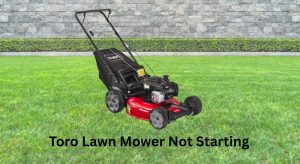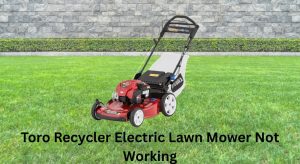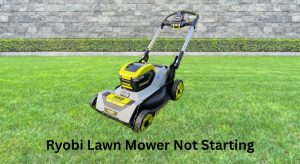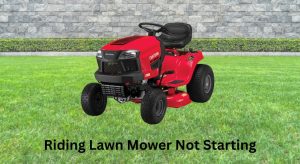When your lawn mower blade is not spinning freely, mowing becomes a chore—or worse, unsafe. The quick fix to try first: disconnect the spark plug, tip the mower safely, and check for grass buildup or a stuck object in the deck. Clearing debris and freeing the blade often restores smooth rotation in minutes.
In this complete guide, you’ll learn every likely cause of a stiff or stuck mower blade and how to fix each one—from simple cleaning and blade removal to diagnosing a seized spindle, bad brake, or failing clutch. By the end, you’ll know how to restore free blade movement, prevent future issues, and decide when it’s time to call a pro.
Common Causes of a Lawn Mower Blade Not Spinning Freely

- Packed grass and debris under the deck causing friction or blockage
- Bent blade or damaged blade adapter
- Blade bolt overtightened or cross-threaded
- Seized or failing spindle bearings (deck mandrel)
- Blade brake stuck engaged (walk-behind safety brake)
- PTO/clutch issues (riding mowers) including belt binding or electric clutch failure
- Deck belt routing wrong or belt tension too tight
- Bent crankshaft (walk-behind) from impact with rocks or stumps
- Rust/corrosion on the spindle shaft or blade hub
- Foreign objects wrapped around the spindle (wire, rope, vine)
How to Fix a Lawn Mower Blade Not Spinning Freely

Important: Always prioritize safety. For walk‑behind mowers, pull the spark plug lead before working near the blade. For riding mowers, remove the key, disconnect the battery negative cable, and set the parking brake.
Method 1: Quick Deck Clean and Blade Free-Up
This addresses the most common cause: debris jam.
Diagnosing the Issue
- Symptoms: Blade moves but feels gritty, stops abruptly, or only turns a fraction of a revolution.
- Check for: Caked, wet grass clumps; sticks, mulch, stones lodged in the deck; twine wrapped around the spindle.
Fix Steps
- Power Down Safely
– Walk-behind: Remove spark plug wire.
– Riding: Remove key, disconnect battery negative terminal. - Tip the Mower Correctly (Walk-Behind)
– Tip with the carburetor/air filter side up to avoid oil/fuel leaking into the filter or cylinder. Typically, tip the mower with the spark plug side up—consult your manual. - Scrape the Deck
– Use a plastic scraper or putty knife to remove packed grass from the deck shell, especially around the blade tips and spindle. - Inspect for Foreign Objects
– Remove sticks, stones, wire, or rope wrapped around the spindle. - Check Blade Rotation
– With gloves, rotate the blade by hand. It should move smoothly with minimal resistance. A slight “cogging” feel on some units with brakes is normal when brakes are engaged. Confirm the brake is released (see Method 3).
Testing
- Reconnect spark plug/battery.
- Engage blade (if applicable) and run briefly. If the blade spins freely and cuts evenly, you’re done.
Time: 10–20 minutes
Tools: Scraper, gloves
Difficulty: Easy
Method 2: Blade and Adapter Inspection and Reinstallation
If the blade feels tight or wobbly—or you recently hit something—check the blade and mounting hardware.
Diagnosing the Issue
- Symptoms: Blade won’t spin freely, feels off-center, or scrapes the deck. You may see vibration when running.
- Possible causes: Bent blade, damaged blade adapter, or overtightened blade bolt.
Fix Steps
- Remove the Blade
– Disconnect power as above.
– Wedge a block of wood in the deck to stop blade movement.
– Use the correct socket to loosen the blade bolt (counterclockwise on most models). Note the orientation of any washers and the blade adapter. - Inspect Components
– Blade: Check for bends by laying it on a flat surface. If a corner lifts off the surface by more than ~1/8 inch (3 mm), replace it.
– Blade Adapter/Hub: Look for cracks or burrs and ensure keyways are intact. A cracked adapter can bind or wobble.
– Washers and Bolt: Ensure threads are clean and not cross‑threaded. - Clean and Deburr
– Wire brush rust from the adapter and spindle end. Lightly sand burrs. - Reinstall or Replace
– Install the blade with the cutting edge facing the correct direction (usually the sail/flap faces up).
– Use a torque wrench to tighten to the manufacturer’s spec:- Walk-behind: typically 30–60 ft‑lb (40–80 N·m)
- Riding mower blades: typically 70–90 ft‑lb (95–120 N·m)
- Do not overtighten—over-torque can crush spacers and add friction.
Testing
- Rotate by hand. There should be no scraping or heavy resistance. If resistance persists, move to spindle/brake checks.
Time: 20–40 minutes
Tools: Socket set, torque wrench, block of wood, gloves, wire brush
Difficulty: Moderate
Method 3: Check the Blade Brake and Bail Cable (Walk-Behind)
Many walk-behind mowers have a blade brake clutch (BBC) or a simple brake pad that stops the blade when you release the bail bar. If it sticks engaged, the blade won’t spin freely.
Diagnosing the Issue
- Symptoms: Blade feels locked when the bail is released but still drags when you squeeze the bail. You may hear scraping at the brake.
- Visual clue: A small metal brake arm pressing into the flywheel or pulley area near the blade adapter.
Fix Steps
- Confirm Cable Tension
– Squeeze the bail at the handle and watch the brake arm—does it pull fully away from the pulley/flywheel area?
– If not, adjust the cable tension at the handle or mid‑cable adjuster. Tighten until the brake fully releases when the bail is squeezed, but the engine stop still functions when released. - Lubricate Pivot Points
– Apply a light silicone or dry lube to the brake pivot and cable ends (avoid getting lubricant on the belt or braking surfaces). - Inspect Brake Pad
– If the brake lining is worn or misaligned, it can drag. Replace as needed per the service manual.
Testing
- Rotate the blade by hand with the bail released (should be braked).
- Squeeze the bail fully; the blade should spin more freely by hand. Start the mower and verify blade engages normally.
Time: 15–30 minutes
Tools: Screwdrivers, pliers, light lubricant
Difficulty: Easy to moderate
Method 4: Inspect and Service Spindle Bearings or Mandrel (Walk-Behind and Riding)
Seized or failing bearings will prevent free rotation and can be dangerous.
Diagnosing the Issue
- Symptoms: Grinding noise, heat at the spindle after brief running, or blade turns in “notches” or barely at all.
- With belt removed (riders) or blade off (walk-behind), try spinning the spindle shaft by hand—roughness indicates bad bearings.
Fix Steps (Walk-Behind)
- Remove Blade and Adapter
– Follow Method 2 steps. - Spin the Spindle Shaft
– If rough or seized, replace the bearing or entire assembly (many walk-behinds use sealed bearings pressed into the deck). - Replace Bearings/Assembly
– Press out old bearings with a driver and arbor press; install new sealed bearings of the same specification. If the housing is worn, replace the housing.
Fix Steps (Riding Mower Deck Mandrel)
- Remove Deck Belt
– Note the belt routing. Release tensioner and slip belt off the mandrel pulley. - Spin Pulley by Hand
– If rough or tight, the mandrel bearings are failing. - Replace Mandrel Assembly
– Remove pulley nut, blade, and spindle bolts. Install new mandrel assembly (model-specific). Torque fasteners to spec.
– Consider replacing all deck mandrels in pairs for even performance.
Testing
- Reassemble and rotate blade by hand; it should coast smoothly.
- Run briefly and listen for quiet, consistent rotation.
Time: 45–120 minutes
Tools: Socket set, torque wrench, pullers/press (as needed), service manual
Difficulty: Moderate to advanced
Method 5: Belt, PTO, and Clutch Checks (Riding Mowers)
On tractors and zero-turns, a binding belt or faulty clutch can stop the blade from spinning freely.
Diagnosing the Issue
- Symptoms: With engine off and PTO disengaged, blades feel hard to turn by hand from the pulley. Belt looks too tight or misrouted. PTO won’t fully disengage.
- Electric PTO clutches can drag if the air gap is misadjusted.
Fix Steps
- Verify Belt Routing and Wear
– Compare to the routing diagram under the seat or in the manual.
– Replace belts with OEM size if cracked, glazed, or stretched. - Check Tensioner and Idlers
– Ensure the tensioner arm pivots freely. Grease pivot if serviceable.
– Spin idler pulleys; replace if noisy or rough. - Adjust Electric PTO Clutch Air Gap
– Locate adjustment slots on the clutch (usually 3). Use feeler gauges to set the air gap commonly to 0.012–0.018 in (0.3–0.45 mm) per manufacturer spec.
– If plates are warped or bearing is rough, replace the clutch. - Manual PTO Systems
– Inspect linkage for binding and confirm full disengagement position removes belt tension from the deck.
Testing
- With PTO disengaged and belt installed, the deck pulleys should spin freely by hand with minimal drag.
- Engage PTO at idle to confirm smooth blade engagement.
Time: 30–90 minutes
Tools: Wrenches, feeler gauges, grease, replacement belt/pulleys as needed
Difficulty: Moderate
Method 6: Check for a Bent Crankshaft (Walk-Behind)
A hard impact can bend the crankshaft, causing the blade to bind against the deck or wobble.
Diagnosing the Issue
- Symptoms: Blade hits the deck at one point, excessive vibration, or cannot spin freely even after cleaning and adapter check.
- Quick test: Rotate the blade by hand and observe the gap between blade tips and the deck lip—if it changes noticeably, the crank may be bent.
Fix Steps
- Measure Runout
- Remove the spark plug and blade. Use a dial indicator against the crank end or blade adapter surface. More than ~0.005–0.010 in (0.13–0.25 mm) runout suggests a bend.
- Remedies
- Minor bends: Some shops use straightening jigs, but replacement is the reliable fix.
- Severe bends: Replace the engine or crankshaft. If the mower is older, replacement may be more cost-effective.
Time: 20 minutes to diagnose; repair varies widely
Tools: Dial indicator, straightedge
Difficulty: Advanced (professional recommended)
How to Prevent Future Blade Binding
- Clean the deck after each mow, especially when grass is wet or lush.
- Sharpen and balance blades every 20–25 hours; replace if bent or cracked.
- Use proper torque on blade bolts to avoid crushing spacers or causing drag.
- Keep belts, idlers, and tensioners in good condition; lubricate serviceable pivots.
- Avoid mowing over hidden objects; walk the area first if debris is likely.
- Store the mower dry; moisture accelerates rust and bearing failure.
- For walk-behinds, periodically adjust the brake/bail cable to prevent partial engagement.
Pro Tips
- Always wear cut-resistant gloves when handling blades.
- Use a deck wash port or hose after mowing, then run the blade briefly to sling off water and reduce rust.
- If debris buildup is chronic, apply a dry graphite deck spray to reduce sticking.
- Replace idler pulleys in pairs; a new belt on worn pulleys can still drag.
- Keep a photo of belt routing before removal—it saves time and prevents misrouting that causes binding.
- Mark blade orientation with a paint pen before removal; reinstalling upside down ruins cut quality and can scrape.
- When in doubt about vibration or binding after an impact, stop using the mower—running with a bent crank or spindle can cause dangerous failures.
When to Call a Professional
- The blade still won’t spin freely after cleaning, adapter check, and brake adjustment.
- Spindle/mandrel bearings are seized or you hear grinding/roaring under the deck.
- Electric PTO clutch requires replacement or you cannot set the air gap.
- Suspected bent crankshaft or severe vibration persists.
- Cracked deck shell, mounting points, or mandrel housings.
What to look for in a service provider:
– Brand-certified technicians or strong reviews for your mower type
– Quotes that include parts/labor and torque specs
– Warranty on repairs (typically 30–90 days)
Typical costs (ranges vary by region and model):
– Blade replacement: $20–$70 parts, $30–$80 labor
– Mandrel/spindle assembly: $50–$180 parts, $80–$200 labor
– Electric PTO clutch: $150–$350 parts, $100–$200 labor
– Belt and idlers: $40–$150 parts, $60–$150 labor
– Crankshaft/engine replacement: often $300–$700+ (may exceed mower value)
Warranty considerations:
– Using OEM blades, belts, and clutches helps protect warranty.
– Keep receipts and maintenance logs.
FAQ
Q: My lawn mower blade is hard to turn by hand. Is that normal?
A: With the engine off and safety disengaged, the blade should rotate smoothly with light resistance. Some walk-behinds have a brake that stops the blade when the bail is released, so it may feel locked until you pull the bail. If it’s still tight with the brake released, look for debris, bent parts, or bearing issues.
Q: Can an overtightened blade bolt cause binding?
A: Yes. Over-torque can compress spacers or deform the adapter, increasing friction. Use a torque wrench and follow your manual’s spec (often 30–60 ft‑lb for walk-behinds, 70–90 ft‑lb for riders).
Q: How do I know if my spindle bearings are bad?
A: With the belt off (rider) or blade removed (walk-behind), spin the spindle shaft or pulley. Roughness, grinding, play, or heat after brief running indicate failing bearings that need replacement.
Q: The blade hits the deck at one spot. What’s wrong?
A: Likely a bent blade, damaged adapter, or bent crankshaft/spindle. Try a new, balanced blade first. If the issue persists, check adapter and measure crank/spindle runout.
Q: Should I lubricate the blade spindle?
A: Many modern spindles use sealed bearings that don’t require grease. Some riding mowers have grease zerks—follow your manual and avoid over-greasing, which can blow seals.
Q: My riding mower blades won’t free-spin with PTO disengaged. Is that okay?
A: They should spin with minimal drag. If they’re hard to turn, check belt routing, tensioner/idler bearings, and the PTO clutch air gap. Drag from a failing clutch or misrouted belt can cause binding.
Q: Is it safe to tip my mower on its side?
A: Yes, but only with the carburetor/air filter side up to prevent oil/fuel flooding. When possible, tip the mower back onto its handle. Always remove the spark plug wire first.
Alternative Solutions
If repeated binding happens in wet or heavy grass, consider these options:
| Solution | Pros | Cons | Best For |
|---|---|---|---|
| High-lift blade | Better discharge, less clumping | Higher engine load | Side-discharge mowing |
| Non-stick deck coating | Reduces buildup | Needs reapplication | Wet grass conditions |
| Mulching kit (matched blade + baffles) | Finer clippings, cleaner cut | Can clog in very wet grass | Regular, dry mowing |
| Upgrade to aluminum or fabricated deck | Smoother underside, stronger | Higher cost | Heavy users, rough terrain |
Get Your Mower Spinning Smoothly Again
By now you’ve seen the most common fixes for a lawn mower blade not spinning freely:
– Clear packed debris and foreign objects from the deck
– Inspect, balance, and correctly torque the blade and adapter
– Adjust blade brake/bail cables so the brake fully releases
– Service spindle/mandrel bearings and idler pulleys
– Check belt routing, tensioners, and PTO clutch air gap
– Diagnose impact damage like bent crankshafts or spindles
Follow these steps in order, and you’ll restore smooth, safe blade operation and a clean cut. Don’t let a stubborn blade sideline your lawn care—spend 20 minutes on the quick fixes today and prevent costly repairs later.
Have you fixed your blade issue? Share what worked for you in the comments. Found this guide helpful? Bookmark it for future reference. Still stuck? Describe your mower model and symptoms for personalized advice.





